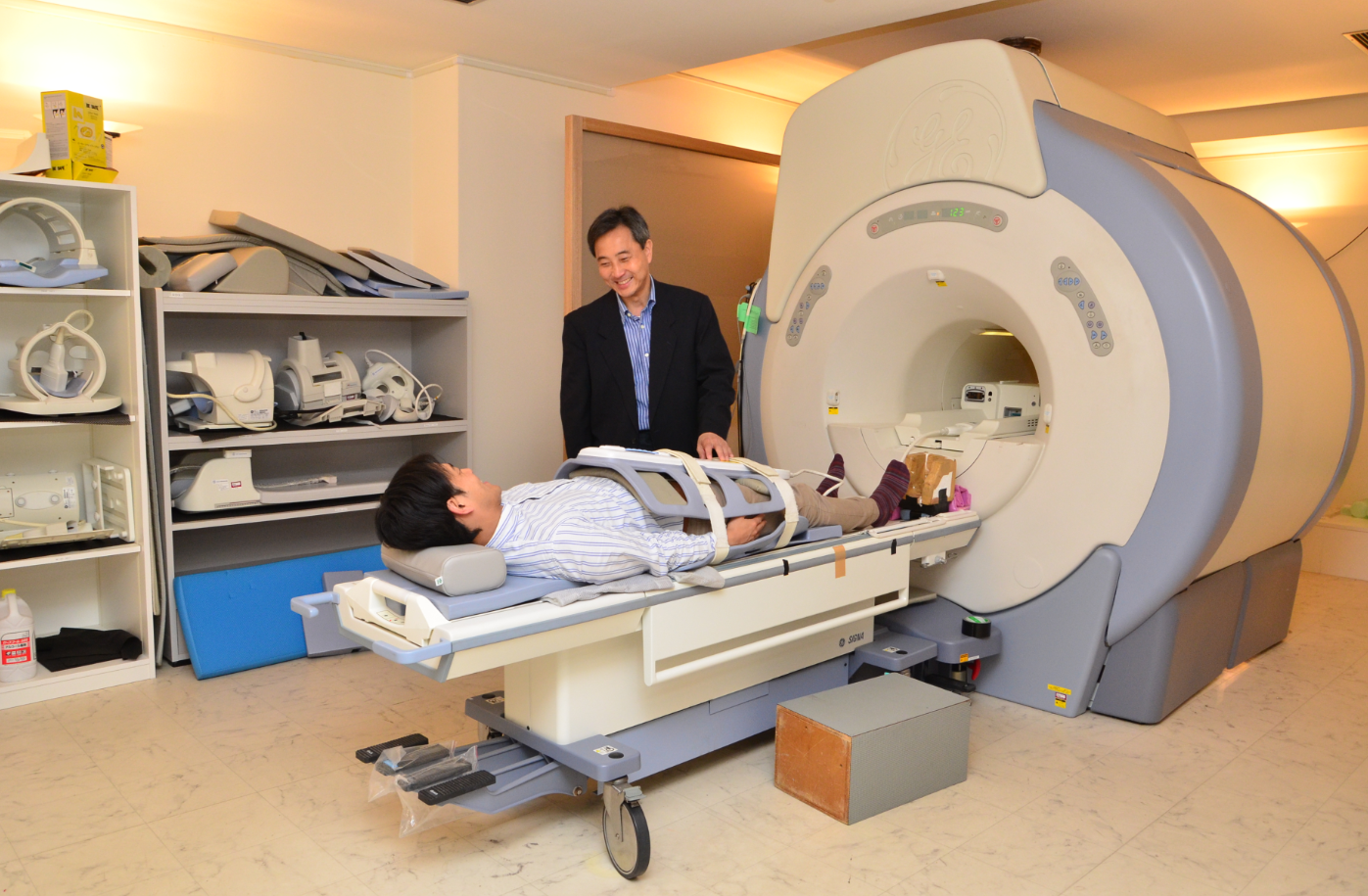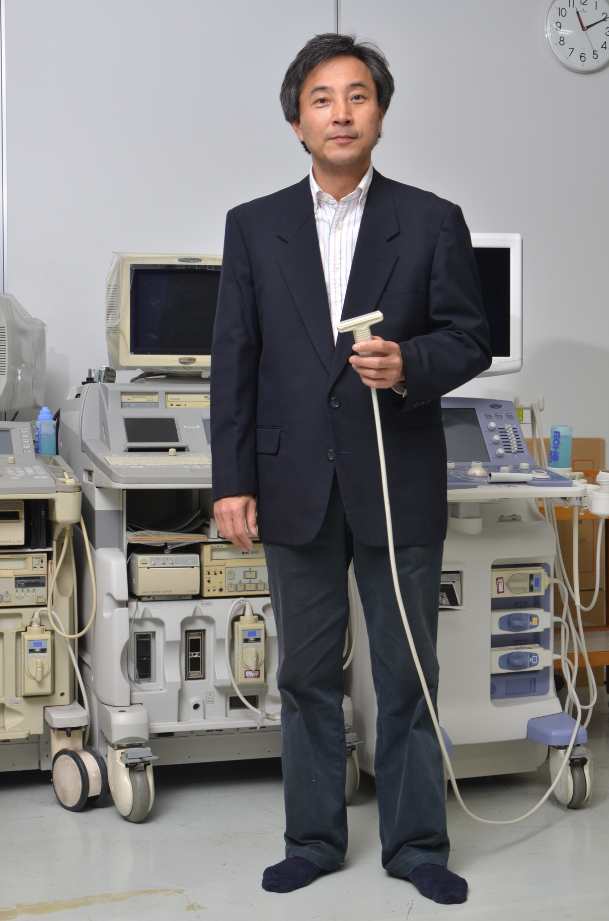Waseda Frontline Research Vol. 7, Part 4 – Can science win medals? Using science at the 2020 Tokyo Olympics!
Fri, Jan 29, 2016-
Tags
Exercise physiology and biomechanics researcher
Professor Yasuo Kawakami, Faculty of Sport Sciences
Creating a healthy society with biomechanics research

Learning about the mechanisms of physical exercise may help not only top athletes but also average people live more fulfilling lives. In the final part of this volume, we discuss the social influence and potential of Professor Yasuo Kawakami’s biomechanics research as he attempts to accomplish his goal of winning medals with science.
Using “shaki-shaki exercise” to change society by asking “why?”
The most important question to me as a researcher is “why?” Even when faced with a physiological or mechanical issue that we cannot solve immediately, the ability to ask “why?” helps us see the light.
Take “shaki-shaki exercise” for example, something we developed in my lab for the elderly to improve muscle power in their legs, increase overall flexibility, and improve balance. We developed the system using our accumulated scientific knowledge. As part of the Healthy City Declaration in 2011, “shaki-shaki exercise” is offered as an alternative to radio gymnastic exercises for the middle-aged and elderly in Nishi-Tokyo city, which has a population of around 200 thousand people. It was introduced alongside the catch phrase “Get healthy with a smile.” We are now working on a version for children that will allow people of all ages to get “healthy with a smile.”
We started developing this exercise system by asking, “Why does muscle strength deteriorate so quickly in the elderly?” To find out which muscles deteriorate in strength the most, we took various measurements and conducted research. We found that the femur area, or the thigh area, loses the most strength. Next, we investigated why the femur area in particular loses strength. We discovered that people rarely use the femur area for significant activity in everyday life. Based on this finding, we developed an optimum training method for getting the femur area into shape.
We can secure the range of motion for specified areas in order to prevent muscle deterioration in the elderly. Using this program, we can preserve and improve the balance required to prevent falls. “How” will reveal itself once we understand “why.”
I am currently subhead of Nishi-Tokyo City’s Health Support Party. In Nishi-Tokyo City, slogans such as “Know your own health” and “Enjoy life with exercise and sports” emphasize the importance of leading healthy lifestyles so that citizens can embrace a lifetime of healthy living. I believe we can work towards the development of healthy local governments by analyzing the results of “shaki-shaki” exercise to determine to what extent it helps reduces medical costs.
I am conducting joint research with Professor Shigenobu Shibata, who teaches in the Department of Electrical Engineering and Bioscience at Waseda University’s School of Advanced Science and Engineering, along with Professor Mitsuru Higuchi and others from Waseda University’s Faculty of Sport Sciences. Our research focuses on the “development of next-generation food and exercise recipes that take into consideration the best time for nutrition and exercise for the elderly.” This is an initiative project, and part of the Cabinet Office’s “Strategic Innovation Creation Program (SIP).”
Our research project investigates the workings of the human body clock based on DNA testing. Through our research, we hope to contribute to human health by determining the ideal time for nutrition and exercise for various individuals. Eventually, we plan to have sports clubs and other organizations throughout Japan utilize and distribute these exercise plans and food recipes. We hope a wide range of people from average families to hospital patients and those in elderly care facilities throughout the community will utilize our proposals and help extend the “healthy life expectance” of the Japanese people.
Improving your research with inspiration found in scientific exchange
To become successful, I believe researchers need to ask “why” at all times
The human body is still full of mysteries, and at times our research resembles a jigsaw puzzle. We fit pieces together one by one, but we still cannot see the whole picture. Even if we think we see it, we often realize we made a mistake somewhere along the way. In spite of that, we continue to plug away at fitting pieces together, one at a time, while imagining what the whole picture looks like. This is the essence of a true researcher. A researcher often patiently deals with a great deal of small, seemingly menial tasks. I suppose researchers find great enjoyment in these tasks as they constantly asking “why.”

Professor Kawakami standing in front of research equipment at his lab in Tokorozawa Campus
Working from that perspective, I find that Waseda University offers an environment that makes it easy to cross over into different fields of research. This has allowed me to find new things to enjoy. I have been carrying out joint research with a robot researcher to develop a running robot. By utilizing the running data I have compiled from people, I make suggestions on how to get the robot running like a human, and the robot researcher can actually develop a robot based on that. Through this collaboration, we can observe the robot to find a way to make humans run faster.
As part of the 2014 Top Global University Project (Type A (SGU)), Waseda University has experienced a significant increase in international exchange. In March of this year, I invited a joint researcher from South Korea. I also went to the University of Calgary and Ottawa University in Canada to explore partnerships. Each time I meet with researchers from various places overseas, it is a testament to the high standards held by Waseda University for the field of Sports Sciences. We are currently considering establishing a research network with Australia.
I believe more Professors at the Faculty of Sport Sciences should be conducting classes in English, and that more emphasis be placed on overseas activities. However, if too much effort is put into overseas activities, we will lose sight of what we have going at home. It is important to build on my own place in this world. I think that by refining my research methods in biometrics, namely by studying physique and functionality in the human body, I can help strengthen collaboration with overseas researchers.
I have been inspired by the ideas I exchange within the community and with researchers in various fields from Japan and abroad. I have received a spark of inspiration that motivates me to continue expanding the possibilities of my own research. I hope to continue making good use of my environment to accomplish this.
Profile

Yasuo Kawakami graduated from the University of Tokyo with a degree from the Faculty of Education’s Division of Physical and Health Education (Physical Education Course) in 1988. In 1990, he acquired a Master’s Degree from the University of Tokyo’s Graduate School of Education and withdrew from the doctoral program in 1991. In 1991, he worked as an assistant at the University of Tokyo’s College of Arts and Sciences, in the Department of Health and Physical Education. In 1996, he worked as an assistant at the University of Tokyo’s Graduate School of Arts and Sciences in Multi-Disciplinary Sciences, and was promoted to assistant professor in 1999. In 2003, he became an assistant professor at Waseda University’s School of Sport Sciences. He became a professor at Waseda University’s Faculty of Sport Sciences in 2005.
Accomplishments and research
-
2015~,川上筋腱特性開拓プロジェクト, 人間の筋腱特性とその可塑性に関する包括的研究:身体運動能力との関連性からみた効果的なトレーニング方策の確立に向けて(中核研究者課題)
- 2012~2015,身体運動のメカニズムと適応性の解明:骨格筋・腱動態の生体計測によるアプローチ(科研費課題)
- 2009~2011,筋肉痛の発生機序と部位特異性:筋肉痛を抑えながら筋力増強効果を高めるトレーニング(科研費課題)
Reference
- Ema, R., Wakahara, T., Yanaka, T., Kanehisa, H., Kawakami, Y. Unique muscularity in cyclists’ thigh and trunk: a cross-sectional and longitudinal study. Scand. J. Med. Sci. Sports, 2015. doi: 10.1111/sms.12511.
- Miyamoto, N., Kawakami, Y. No graduated pressure profile in compression stockings still reduces muscle fatigue. Int. J. Sports Med. 36: 220-225, 2015. doi: 10.1055/s-0034-1390495.
- Sakaguchi, M., Shimizu, N., Yanai, T., Stefanyshyn, D., Kawakami, Y. Hip rotation angle is associated with frontal plane knee joint mechanics during running. Gait & Posture 41: 557-561, 2015. doi:10.1016/j.gaitpost.2014.12.014
- Shishida, F., Sakaguchi, M., Sato, T., Kawakami, Y. Technical principles of Atemi-waza in the first technique of the Itsutsu-no-kata in Judo: from a viewpoint of Jujitsu-like Atemi-waza. Sport Science Research 12: 121-136, 2015.
- Akagi, R., Iwanuma S., Hashizume, S., Kanehisa, H., Fukunaga, T., Kawakami, Y. Determination of contraction-induced changes in elbow flexor cross-sectional area for evaluating muscle size-strength relationship during contraction. J. Strength Cond. Res. 29: 1741-1747, 2015.
- Wakahara, T., Ema, R., Miyamoto, N., Kawakami. Y. Increase in vastus lateralis aponeurosis width induced by resistance training: implications for a hypertrophic model of pennate muscle. Eur. J. Appl. Physiol. 115: 309-316, 2015.
- Sugisaki, N., Wakahara, T., Murata, K., Miyamoto, N., Kawakami, Y., Kanehisa, H., Fukunaga, T. Influence of muscle hypertrophy on the moment arm of the triceps brachii muscle. J. Appl. Biomech. 31: 111-116, 2015. doi: 10.1123/jab.2014-0126.
 This interview took place at Tokorozawa Campus, home to the Faculty of Human Sciences and the Faculty of Sport Sciences
This interview took place at Tokorozawa Campus, home to the Faculty of Human Sciences and the Faculty of Sport Sciences













